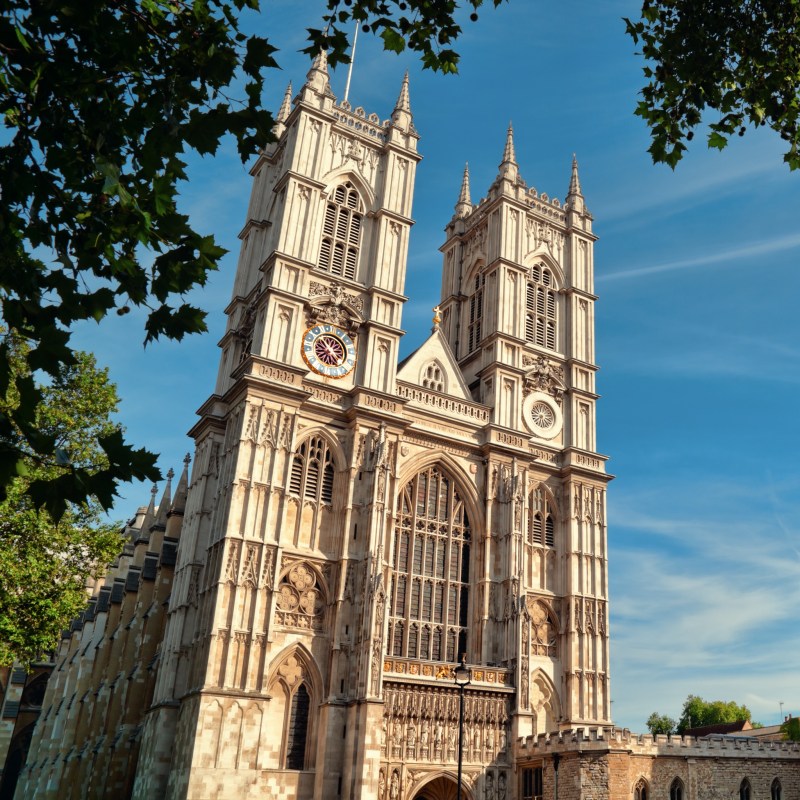
Westminster Abbey is a UNESCO World Heritage site and one of the best-known landmarks of London. It’s close to the Houses of Parliament and is easy to reach by bus, Tube, or boat.
Videos by TravelAwaits
The building itself is an outstanding medieval Gothic church, with some even older parts. The vast collection of tombs, statues, and other memorials is a fascinating three-dimensional encyclopedia of British history. If that weren’t enough, this royal church has been the site of many famous events.
Westminster Abbey is about as awe-inspiring a church as you could imagine. It offers daily services and even boasts the shrine of a saint at its heart.
Here are 16 reasons to visit Westminster Abbey on a trip to London.
1. It Boasts More Than 1,000 Years Of History
The Saxons built a church to honor Saint Peter on the site in the early 700s. Around 960, that church became a small Benedictine abbey. In the mid-1000s, the last Saxon king, Edward, built a new abbey called West Minster. He also built the original Palace of Westminster.
King Edward’s Westminster Abbey was consecrated in December of 1065. The Pyx Chamber and Undercroft and Britain’s oldest door are all that remain of that building.
The present Gothic-style abbey was built in the 1200s by King Henry III as a grander replacement.
The Henry VII Lady Chapel was added in the 1500s, and the two towers by the Great West Door are from the 1700s.
Westminster Abbey continues to change and grow, as the recent Triforium Project demonstrates.

2. It’s A UNESCO World Heritage Site
The Palace of Westminster (Houses of Parliament), Saint Margaret’s Church, and Westminster Abbey together make up a UNESCO World Heritage site.
At the nearby medieval Jewel Tower, interpretive signs show how the old palace and the abbey functioned as one site, with no busy street separating them.
3. The Figures Of The Great North Door Are Incredibly Detailed
Visitors enter the abbey by the Great North Door, where detailed carvings and gargoyles set the medieval stage.
4. There Are Monuments To British Politicians And Statesmen
White marble statues of three men from the Canning family are among the first things you’ll see inside.
This is the North Transept, also called Statesmen’s Aisle. It’s full of memorials to politicians, many from the Victorian period.
In the nave, you’ll find additional monuments to politicians, some depicting dramatic scenes like Prime Minister Spencer Perceval’s assassination in the House of Commons in 1812. Toga-clad Charles James Fox, who served as Foreign Secretary, is melodramatically draped in the arms of Liberty.

5. The Building Itself Is Magnificent
As you enter the building, you’ll see just how spacious and beautiful Westminster Abbey is.
The Gothic architecture evokes a spiritual atmosphere. Your gaze is drawn up the vast stone columns. The columns branch out at the tops, where ribbed vaulting supports the high ceiling. The pointed arches of the windows and doors, the great circular rose windows, the extensive use of stained glass, the flying buttresses, and the delicate appearance of the stonework are all characteristic of the world’s great Gothic medieval cathedrals.
Later, you’ll see the Henry VII Lady Chapel. Its ornate ceiling uses an ingenious design called fan vaulting, supported by pendants.
6. It Honors Britain’s Best Engineers, Architects, And Scientists
The windows and monuments in the nave honor engineers, architects, and scientists. Robert Stephenson’s window shows the famous Rocket locomotive.
Think of a great name from British science and engineering, and chances are you’ll find that person here. In 2018, Professor Stephen Hawking joined Sir Isaac Newton and Charles Darwin at Westminster Abbey.
8. It’s Home To Britain’s Tomb Of The Unknown Warrior
On November 11, 1920, the body of an unidentified British warrior killed during World War I was buried here in soil from France. Looking upon his simple grave is a moving experience.
Walking along through the quire (or choir), you are reminded that music is an integral part of the abbey’s daily life.

9. It’s A Royal Peculiar
Westminster Abbey is one of a small number of churches known as Royal Peculiars. These churches are under the direct supervision of the monarch rather than being the responsibility of a bishop.
10. It’s The Place Where Kings And Queens Are Crowned
Since 1066, Westminster Abbey is where English monarchs have been crowned using some of the Crown Jewels from the Tower of London.
For the ceremony, the Coronation Chair is placed on the Cosmati Pavement. This richly patterned mosaic of stones and glass was created by Italian craftsmen in 1268 and has been beautifully restored.
11. Adventurers And Generals Are Interred There
Fans of Arctic exploration will know that Sir John Franklin and all his men died trying in vain to find the Northwest Passage. Franklin’s memorial in Saint John the Evangelist’s Chapel features a bust of him above a carving of his ships, Erebus and Terror, fatefully trapped in the Hudson Bay ice.
The large monument to General James Wolfe depicts the Battle of the Plains of Abraham in Quebec City, in which the English defeated the French in 1759. The sculpture shows how the soldiers came by boat on the Saint Lawrence River, pulled their cannons up the steep cliffs, and attacked by surprise.

12. A Saint Is Buried There
The average visitor to Westminster Abbey may not know they’re in the presence of a saint. About 100 years after building the abbey, King Edward became Saint Edward the Confessor. His shrine is the heart of Westminster Abbey. In October, the abbey celebrates Saint Edward’s feast day.
King Henry III honored Saint Edward by building the Gothic Westminster Abbey and the shrine. Henry’s own tomb is not far away.
Until the mid-1300s, Saint Edward was the patron saint of England, but then he was ousted by the feisty dragon-slayer, Saint George.
13. Many British Royals Are Buried There
There are 30 royal tombs in Westminster Abbey. Many of these tombs have life-size effigies on top. These are fascinating, partly because they show how high-ranking people used to dress, but mainly because they are so unusual. I hadn’t expected to see a knight in armor lying on his back.
The Tudor family is prominent. The Lady Chapel contains the tomb of the first Tudor king, Henry VII, and his wife, Elizabeth of York. Their famous son, King Henry VIII, is not buried at Westminster Abbey (he’s at Windsor), but all three of his children are, and so is his fourth wife, Anne of Cleves.
Queen Elizabeth I’s effigy wears an ornate crown and holds an orb and scepter. She lies near her half sister, Queen Mary I, the one who put her in the Tower.
14. It Has Hosted Numerous Royal Weddings And Funerals
Did you watch the wedding ceremony of Kate Middleton and Prince William in April of 2011? In pictures of them exchanging vows, you can see the Cosmati Pavement.
Queen Elizabeth II was married here in 1947, when she was still a princess.
There have been 16 royal weddings at Westminster Abbey, starting in 1100.
Monarchs are no longer buried here, but funerals and memorial services continue. Princess Diana’s funeral in 1997 and the Queen Mother’s in 2002 were both major events for Westminster Abbey.

15. It Honors Famous Poets, Writers, And Musicians
Coming from the royal tombs into the Poets’ Corner, there’s a change in the place’s mood. It lightens up as you see memorials to notable British artists (not just poets) like the Bronte sisters, William Shakespeare, Jane Austen, and Thomas Hardy. There are more than 100 of these memorials, and the list is still growing.
Charles Dickens hadn’t wanted a big funeral, and he hadn’t asked to be buried in Westminster Abbey. His funeral was a secret, and his marker bears plain text with just his name and dates.
The statue of the musician George Frideric Handel, on the other hand, is holding sheets of printed music and looks to be keeping time with his foot.
The access to the cloisters and the beautiful Chapter House is nearby.
16. The Modern Martyrs Sculptures Are Unique
After you leave the abbey through the Great West Door, look back. The Modern Martyrs sculptures, unveiled in 1998, honor 10 Christians who died for their beliefs. Dr. Martin Luther King Jr. and Saint Oscar Romero are two of them.
What To Know Before You Go
There is an admission charge to enter Westminster Abbey as a tourist.
The abbey holds worship services every day. On some days, the abbey is only open for services, not for tourists. It’s essential to check the website in advance of your visit, whether you plan to visit as a tourist or as a worshipper.
Saint Margaret’s Church, right beside Westminster Abbey, is free to enter, though as with all churches, you should expect to give a donation. It too has a rich history and a variety of monuments, including one to a Beefeater who served the Tudors.
The abbey’s accessibility features are described on the website.
If you need a break, just sit down and look up. It’s an inspiration.
